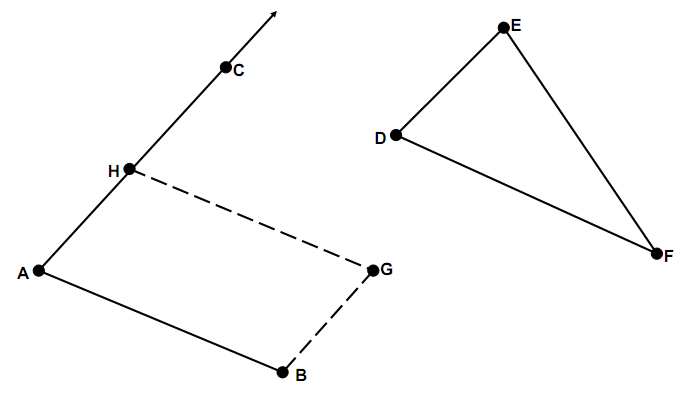Euclid
In one of his notebooks, Euclid gave a complex procedure for solving the following problem. With computers, perhaps there is an easier way.
In a 2D plane, consider a line segment AB, another point C which is not collinear with AB, and a triangle DEF. The goal is to find points G and H such that:
H is on the ray AC (it may be closer to A than C or further away, but angle CAB is the same as angle HAB)
ABGH is a parallelogram (AB is parallel to HG, AH is parallel to BG)
The area of parallelogram ABGH is the same as the area of triangle DEF

There will be several test cases. Each test case will consist of twelve real numbers, with no more than 3 decimal places each, on a single line. Those numbers will represent, in order:
AX AY BX BY CX CY DX DY EX EY FX FY
where point A is (AX,AY), point B is (BX,BY), and so on. Points A, B and C are guaranteed to NOT be collinear. Likewise, D, E and F are also guaranteed to be non-collinear. Every number is guaranteed to be in the range from -1000.0 to 1000.0 inclusive. End of the input will be signified by a line with twelve 0.0's.
For each test case, print a single line with four decimal numbers. These represent points G and H, like this:
GX GY HX HY
where point G is (GX,GY) and point H is (HX,HY). Print all values rounded to 3 decimal places of precision (NOT truncated). Print a single space between numbers. Do not print any blank lines between answers.
0 0 5 0 0 5 3 2 7 2 0 4 1.3 2.6 12.1 4.5 8.1 13.7 2.2 0.1 9.8 6.6 1.9 6.7 0.0 0.0 0.0 0.0 0.0 0.0 0.0 0.0 0.0 0.0 0.0 0.0
5.000 0.800 0.000 0.800 13.756 7.204 2.956 5.304
Submit
